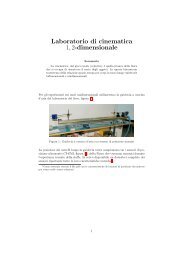Newton's law of cooling revisited - Cartan
Newton's law of cooling revisited - Cartan
Newton's law of cooling revisited - Cartan
You also want an ePaper? Increase the reach of your titles
YUMPU automatically turns print PDFs into web optimized ePapers that Google loves.
Newton’s <strong>law</strong> <strong>of</strong> <strong>cooling</strong> <strong>revisited</strong> 1071<br />
(a)<br />
(c)<br />
(b)<br />
Figure 3. Numerical results <strong>of</strong> equation (10) for Al metal cubes. (a) Variation <strong>of</strong> cube size from<br />
1to100cmforfixedαConv = 10 W (m 2 K) −1 and ε = 0.9. (b) Variation <strong>of</strong> the convective heat<br />
transfer coefficient αConv from1to100W(m 2 K) −1 for fixed size (s = 4cm)andε = 0.9. (c)<br />
Variation <strong>of</strong> the emissivity for fixed αConv = 10 W (m 2 K) −1 and cube size s = 4 cm. In (b) and<br />
(c), numbers from top to bottom refer to curves from top to bottom.<br />
It is quite obvious that all plots show deviations from straight lines (broken lines), which<br />
nicely fit the low temperature data. The larger the convective heat transfer, the smaller the<br />
deviations. For low convective losses <strong>of</strong> only 3 W m −2 K, deviations can already be expected<br />
for temperature differences as small as 40 K. In contrast for very high convective losses <strong>of</strong> 30<br />
Wm −2 K, simple exponential <strong>cooling</strong> seems to work quite well for �T < 100 K.<br />
The results demonstrate that there is no general number for �T describing the range <strong>of</strong><br />
validity <strong>of</strong> Newton’s <strong>law</strong>. Rather, the respective temperature range depends on the experimental<br />
conditions and how close one looks for deviations. Plotting data only for small temperature<br />
differences can lead to the impression that the straight line works quite well since deviations<br />
are not as pronounced as for the high temperature range.<br />
The results from figure 3 can be used to consider the two extreme cases for the <strong>cooling</strong> <strong>of</strong><br />
objects, one where radiation dominates and another where convection dominates the <strong>cooling</strong><br />
process. Results are depicted in figure 5. The smallest imaginable realistic value for the<br />
convective heat transfer is in the range <strong>of</strong> 1 W m −2 K; the largest respective radiative heat<br />
transfer occurs for black bodies, i.e. setting ε = 1.0 as may be realized by metal cubes covered<br />
with high emissivity paint. In this case, the <strong>cooling</strong> curve already starts to deviate from<br />
Newton’s <strong>law</strong> for �T ≈ 30 K. In contrast, polished metal cubes with low emissivity reduce<br />
radiation losses. The convective losses may simultaneously be enhanced by directing fans




